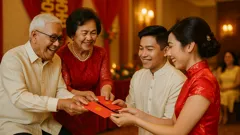What is the reason that the majority of Asian wedding ceremonies emphasize the wedding tradition of the red envelope? What does this tradition mean for couples who are beginning an adventure together and what are the rules that govern the guests' experience?

The Symbolic Power of Red Envelopes
The envelope in red, also known as "hongbao" in Chinese and "bao li xi" in Vietnamese It's more than a simple cover for cash. It's a symbol of luck joy, happiness and a sense of community. From the soft glow of silk papers to the energizing red hue, each aspect emphasizes the desire for a happy wedding. The tradition began in the Han Dynasty and continues to be heard in wedding ceremonies across China, Vietnam, and Taiwan today.

Red Envelope Customs: Breaking Down the Ritual
Asian wedding customs provide an in-depth understanding of how red envelopes are weaved into the celebration. In Chinese weddings the tradition is found in its place in the tea ceremony. During this time, newlyweds are honored by their elders and receive envelopes to show respect and unity in the family. When it comes to Vietnamese celebrations, presenting envelopes is often a centerpiece, and guests generally preferring cash gifts with even numbers, excluding the number 4, which is considered to be a sign of bad luck.
The most memorable moments don't occur in boxes that are unwrapped but through the tender exchange of red envelopes accompanied with genuine wishes and heartfelt smiles.
Taiwanese tradition extends the red envelope ceremony beyond the family circle: envelopes could be handed out to wedding party members or even servers and servers, expressing gratitude to all directions. It's practical, helping to offset wedding costs--and profoundly symbolic, as each envelope conveys joy and wealth to the person who receives it.
The Etiquette of Giving and Receiving
Similar to choosing the ideal outfit for the season and the occasion Understanding the proper manners to use an envelope is vital. The envelope that you deposit cash in shows the intimacy of your relationship with your partner: the more solid the tie, the more the amount. Always hand out envelopes with both hands, a gesture that reflects the sincerity displayed in respectful clothes.
As with pairings of fabrics there are some rules to follow. Don't open an envelope of red right in front of the recipient and beware of giving gifts that contain the number four that is pronounced as "death" in both Chinese and Vietnamese. Numbers like eight and nine are often associated with longevity and prosperity. Imagine choosing the smooth cloth of luck to the rough surface of superstition!
Finding the Perfect Red Envelope
Are you looking for red envelopes that are perfect for an upcoming wedding? Today, you can find beautifully designed envelopes in specialty stores as well as on the internet, often embossed, silk-touched, or ready to be personalized. Couples who value the tradition of both, reuse their envelopes for the Lunar New Year, giving them a pattern-like year of renewal.
Final Thoughts: Tradition Woven for Modern Celebrations
The Asian wedding customs of gifting red envelopes blend tradition with etiquette, tradition, and generosity. It's a custom that has evolved and accommodates contemporary tastes while keeping its distinctive threads of respect, connection and joy for all at the center of every celebration.
At the end of the day, wedding gift exchange isn't only about the amount it's about expressing an overall wish for happiness and happiness for the couple. One that is as timeless and flexible as a cherished piece of your wardrobe. Isn't this the thing that makes traditions truly stylish?
 Meg Magazine
Meg Magazine















Comments